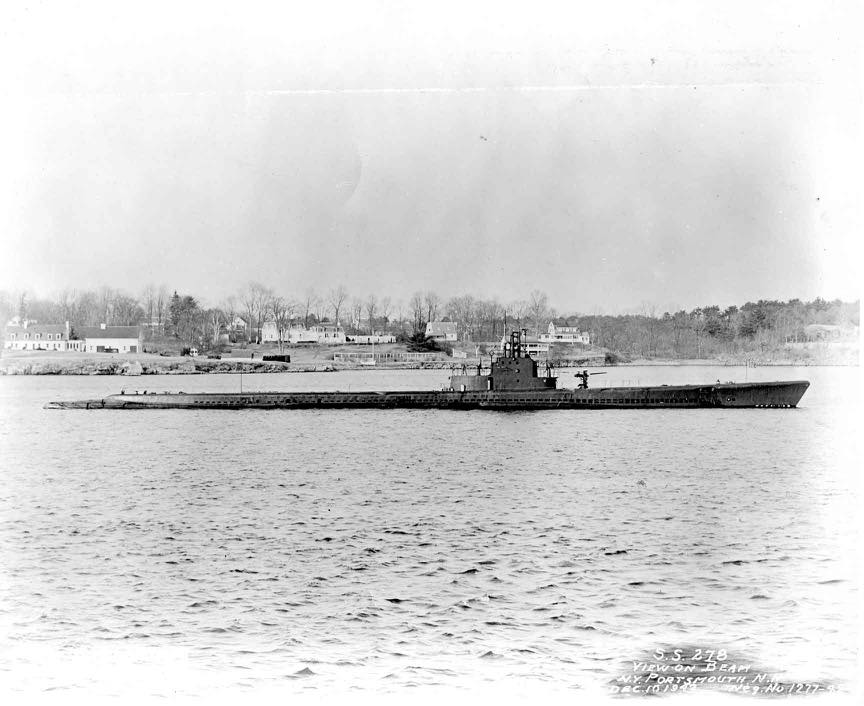Sawfish SS-276

Sawfish
(SS-276: dp. 1,526 (surf.), 2,410 (subm.); 1. 311'8"; b. 27'4"; dr. 15'3"; s. 20.25 k. (surf.), 8.75 (subm.); cpl. 60, a. 10 21' tt., 1 3", 2 .50 eel. mg., 2 .30 eel. mg.; cl. Gato)
Sawfish (SS-276) was laid down on 20 January 1942 by the Portsmouth Navy Yard, Portsmouth, N.H.
launched on 23 June 1942; sponsored by the Honorable Hattie Wyatt Caraway, the first woman to be elected to the United States Senate; and commissioned on 26 August 1942, Lt. Comdr. Eugene T. Sands in command.
After shakedown-off Portsmouth, in Narragansett Bay, and en route to the Panama Canal-the new submarine arrived at Pearl Harbor on 21 January 1943. Ten days later, she got underway for the first of her 10 war patrols.
Sawfish proceeded to waters off southwestern Japan where she attacked several targets and concluded that she had sunk or damaged some. However, a careful study of Japanese and American records after the war did not confirm any sinkings on Sawfish's first war patrol which ended when she reached Midway on 25 March.
The submarine departed Midway on 15 April and headed for Japan. On 5 May off the coast of Honshu she sank the converted gunboat, Hakkai Maru. A fortnight later, she stalked an enemy task force but lost her quarry in heavy swells. She returned to Pearl Harbor on 6 June.
Underway again on the last day of the month Sawfish set course for the East China Sea. On the night of 21 July, she attacked a convoy of nine ships and concluded that she had scored several hits. However, postwar assessment of records was unable to confirm any kills during this attack or during her operations for the next five days.
Finally, early on the morning of the 27th, her luck finally changed when she attacked a convoy escorted by a 720-ton minelayer. Comdr. Sands fired a spread of four torpedoes from a range of only 750 yards. He went deep as soon as the "fish" were clear and, in less than half a minute, the submarine was jolted by a violent explosion. Fearing that the detonation had been premature, Sands remained deep for over an hour. When he ascended to periscope depth, the convoy had escaped, but the escort, coastal minelayer, Hirashima was sinking. Sawfish returned to Pearl Harbor on 10 August.
During her fourth patrol, 10 September to 16 October, defective torpedoes frustrated the seven attacks which she made in the Sea of Japan before she returned to Midway. She got underway for the Bonins and her fifth patrol on 1 November. On 8 December she sank 3,267-ton passenger-cargo ship, Sansei Maru and returned to Midway on the 19th. She soon proceeded to Hunter's Point Navy Yard, San Francisco Calif., for overhaul.
Back in top trim, the submarine returned to Pearl Harbor early in the spring. On 8 April 1944, she got underway for Japanese waters and her sixth war patrol. However, she only encountered two targets: a cargo ship which she attacked on the 25th and a second vessel which she sighted four days later-too fast and too far away for the submarine to attack. Although the submarine reported scoring two hits on the cargo ship, Japanese records contain no evidence of any sinking in the vicinity of the attack.
During her seventh war patrol, Sawfish joined Rock (SS-274) and Tilefish (SS 307) for wolfpack operations. The submarines sortied from Majuro on 22 June and headed for the Philippines. On 18 July, she damaged a tanker and, on the 26th, fired a spread of four torpedoes at surfaced Japanese submarine, 1-29, which exploded and sank. After a fruitless chase of a large Japanese convoy the wolfpack ended the patrol at Pearl Harbor on 15 August.
During Sawfish's eighth war patrol, her commanding officer, Comdr. Alan B. Banister, led a wolfpack which included Drum (SS-228), Icefish (SS-367) and from time to time other submarines. The pack departed Pearl Harbor on 9 September and headed for waters south of Formosa where the submarines took a heavy toll on enemy shipping. Sawfish, herself, accounted for 6,521-ton tanker, Tachibana Maru, on 9 October and 6,838-ton seaplane tender, Kimikawa Maru, on the 23d. During the patrol, Sawfish also served on lifeguard station off Formosa in support of carrier raids. On 16 October, she rescued a pilot who had survived four and one half days at sea in a small rubber boat without food, water, or sunshade. The wolfpack returned to Majuro on 8 November.
Sawfish got underway on 17 December 1944 and returned to waters off Formosa where she spent her entire ninth war patrol on lifeguard station. She rescued a pilot on 21 January 1945 before heading toward Guam. She reached Apra Harbor on 4 February for refit.
Sawfish sailed on 10 March for her 10th and last war patrol which she spent on lifeguard station off Nansei Shoto supporting air strikes preparing for and covering the conquest of Okinawa. She returned to Pearl Harbor on 26 April and soon proceeded to San Francisco for overhaul in the Bethlehem Steel Company yard there. She was ready for action and heading toward Hawaii on 15 August when hostilities ended. She reached Pearl Harbor on the 22nd but soon headed back to the west coast for duty as a training ship for the West Coast Fleet Sound School. She returned to Hawaii early in 1946, but was back at San Francisco on 22 March for inactivation. She was decommissioned on 26 June 1946 and remained in reserve at Mare Island until May 1947 when she proceeded to San Pedro for duty as a Naval Reserve training ship. On 1 April 1960, Sawfish was struck from the Navy list and scrapped.
Sawfish received eight battle stars for service during World War II.
